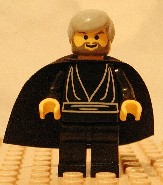 Nethozhen
Nethozhen
A character for CastleWorld by Franklin W. Cain.
All original work herein is Copyright © 2000 Franklin W. Cain. (However, please be sure to read my legal disclaimer.
Basic Information
The name "Nethozhen" is pronounced "neh-THO-zhen", where the "ZH" is pronounced just as the letter "S" is pronounced in the word "treasure".
Nethozhen is a sorceror of tremendous power, with many specialized magics in the fields of necromancy and demonology. However, he can be more accurately described as a mastermind.
Personality and Mannerisms
In terms of "casting" Nethozhen, I picture him as a blend of Sean Connery [1] and Alan Rickman [2].
He's cultured, urbane, and witty. He's also heartless, remorseless, pitiless, and totally and utterly ruthless.
He considers his heavy use Necromancy a matter of "efficiency". As long as he has to kill someone, he might as well extract the largest benefit from the death that he can. Thus his use of soul-drains, spirit-bindings, and channelings.
And, as far as whether or not he has to kill someone, he just asks himself, which would take the lesser amount of effort in the long run, killing the person(s) in question now, or avoiding them and planning around their possible interference until their normal demise?
. . . Exactly. Kill them now.
[1].
Oh, come on!
You know who I'm talking about!
[2].
He played the villainous mastermind Hans Gruber
in the first of the Die Hard movies.
He was also Tom Selleck's nemesis
in Quigley Down Under.
He also played the Sheriff of Nottingham
in Kevin Costner's Robin Hood: Prince of Thieves.
Appearance (i.e., Construction)
A Lego minifig for Nethozhen can be constructed using the Luke Skywalker "Jedi - Tatooine" torso from the Desert Skiff set, the "Grey Beard" head from the old Pirates sets and the Wild West (Cavalry) sets [1], a black fabric cloak from one of the Star Wars sets, and generic/plain black legs. Finally, if he is not wearing a black Jedi/Sith hood/cowl [2] from the Episode One sets then he should be wearing the grey hairpiece (from the Landspeeder set).
Unlike most other wizards, he usually does not carry a mage's staff or a wand. He can summon a shadow-blade (a black katana) at will. He has also been known to carry an enchanted greatsword (one of those ubiquitous chrome greatswords) on occasion.
[1].
This is not the same
as the smiling "Grey Beard" in the new construction sets!
[2].
Not to be confused with the old hood/cowl
from the Wolfpack and/or Dark Forest sets
(from Lego Castle).
History
No one knows from where Nethozhen came. He simply arrived one day, seemingly from nowhere.
Nethozhen has been forming a Circle (i.e., a cabal) of various sorcerors, magi, and wizards, both living -- human, elven (mostly dark-elven, at that), even goblin -- and undead (i.e., liches).
Terms Used
- Demonology
-
The term demonology refers to a subset of magic that deals with creatures of an extra-planar or other-dimension origin and of a malefic nature (i.e., demons). This subset of magic deals with the conjuring (summoning) of these creatures, and with binding these creatures (once summoned) to do the bidding of the summoner.
- Mastermind
-
The term mastermind is one most often found in crime dramas and/or comic books, and is used to refer to a type of villain who delights in large, intricate, convoluted plots, with the necessary actions being most often performed by unwitting dupes or expendable minions (and not by the mastermind himself), and with the purpose of achieving tremendous personal or political power for the villain.
Sherlock Holmes' nemesis, Dr. Moriarty, is an excellent example of a mastermind.
- Necromancy
-
In a certain heroic-fantasy role-playing game, the term necromancy is used to refer to a subset of magic that deals with dead critters and their spirits. This subset of magic also deals with ghosts, haunts, zombies, and other forms of undead.
Throughout his career, Nethozhen has acquired many rare (if not unique) spells of this type.
- Shadow-Blade
-
A shadow-blade is sword, usually forged or cast from a very dark (almost black) alloy, that has the sorcerous ability to drain the very essence (i.e., soul, spirit, strength, psyche, "mana", etc.) of its victims, with this stolen essence usually being redirected to the benefit of the sword-wielder.
Many times, a weapon of this type will prove to have been made not by the hands of a mortal, but by the efforts of extra-planar, supernatural entities of a malefic nature (e.g., by demons). In fact, one story or legend would have it that the shadow-blade in question was itself a demon (albeit, bound into the form of a sword).
Obviously, this type of weapon is used almost exclusively by persons of great evil.